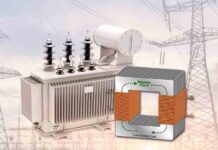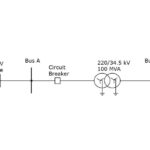
For supplying a load in excess of the rating of an existing transformer, two or more transformers may be connected in parallel with the existing transformer. The transformers are connected in parallel when load on one of the transformers is more than its capacity. The reliability is increased with parallel operation than to have single larger unit. The cost associated with maintaining the spares is less when two transformers are connected in parallel.
It is usually economical to install another transformer in parallel instead of replacing the existing transformer by a single larger unit. The cost of a spare unit in the case of two parallel transformers (of equal rating) is also lower than that of a single large transformer. In addition, it is preferable to have a parallel transformer for the reason of reliability. With this at least half the load can be supplied with one transformer out of service.
Condition for Parallel Operation of Transformer
For parallel connection of transformers, primary windings of the transformers are connected to source bus-bars and secondary windings are connected to the load bus-bars. Various conditions that must be fulfilled for the successful parallel operation of transformers are
- Same voltage ratio and turns ratio (both primary and secondary voltage rating is same)
– Same percentage impedance and X/R ratio.
- Identical position of tap changer
- Same KVA ratings
- Same phase angle shift (vector group are same)
- Same frequency rating
- Same polarity
- Same phase sequence.
Some of these conditions are convenient and some are mandatory. The convenient are same voltage ratio and turns ratio, same percentage impedance, same kva rating, and same position of tap changer. The mandatory conditions are same phase angle shift, same polarity, same phase sequence and same frequency. When the convenient conditions are not met, paralleled operation is possible but not optimal.
Same voltage Ratio & Turns Ratio (on each tap)
If the transformers connected in parallel have slightly different voltage ratios, then due to the inequality of induced emfs in the secondary windings, a circulating current will flow in the loop formed by the secondary windings under the no-load condition, which may be much greater than the normal no-load current. The current will be quite high as the leakage impedance is low. When the secondary windings are loaded, this circulating current will tend to produce unequal loading on the two transformers, and it may not be possible to take the full load from this group of two parallel transformers (one of the transformers may get overloaded).
If two transformers of different voltage ratio are connected in parallel with same primary supply voltage, there will be a difference in secondary voltages. Now, when the secondary of these transformers are connected to same bus, there will be a circulating current between secondary’s and therefore, between primaries also. As the internal impedance of transformer is small, a small voltage difference may cause sufficiently high circulating current causing unnecessary extra I2R loss. The ratings of both primaries and secondaries should be identical. In other words, the transformers should have the same turn ratio i.e. transformation ratio.
Same percentage impedance and X/R ratio
If two transformers connected in parallel with similar per unit impedances, they will mostly share the load in the ration of their KVA ratings. Here, load is mostly equal, because it is possible to have two transformers with equal per unit impedances but different X/R ratios. In this case, the line current will be less than the sum of the transformer currents and the combined capacity will be reduced accordingly. A difference in the ratio of the reactance value to resistance value of the per unit impedance results in a different phase angle of the currents carried by the two paralleled transformers; one transformer will be working with a higher power factor and the other with a lower power factor than that of the combined output. Hence, the real power will not be proportionally shared by the transformers.
The current shared by two transformers running in parallel should be proportional to their MVA ratings. The current carried by these transformers are inversely proportional to their internal impedance.
From the above two statements it can be said that impedance of transformers running in parallel are inversely proportional to their MVA ratings. In other words, percentage impedance or per unit values of impedance should be identical for all the transformers run in parallel.
When connecting single-phase transformers in three-phase banks, proper impedance matching becomes even more critical. In addition to following the three rules for parallel operation, it is also a good practice to try to match the X/R ratios of the three series impedances to keep the three-phase output voltages balanced.
When single-phase transformers with the same KVA ratings are connected in a Y bank, impedance mismatches can cause a significant load unbalance among the transformers.
Let’s examine following different type of case among impedance, ratio and KVA.
If single-phase transformers are connected in a Y-Y bank with an isolated neutral, then the magnetising impedance should also be equal on an ohmic basis. Otherwise, the transformer having the largest magnetising impedance will have a highest percentage of exciting voltage, increasing the core losses of that transformer and possibly driving its core into saturation.
Case 1: Equal Impedance, Ratios and Same kVA
The standard method of connecting transformers in parallel is to have the same turn ratios, percent impedances, and kVA ratings. Connecting transformers in parallel with the same parameters results in equal load sharing and no circulating currents in the transformer windings.
Example: Connecting two 2000 kVA, 5.75 per cent impedance transformers in parallel, each with the same turn ratios to a 4000 kVA load.
Loading on the transformers-1 =KVA1=[( KVA1 / %Z) / ((KVA1 / %Z1)+ (KVA2 / %Z2))]X KVAl
kVA1 = 348 / (348 + 348) x 4000 kVA = 2000 kVA.
Loading on the transformers-2 =KVA1=[( KVA2 / %Z) / ((KVA1 / %Z1)+ (KVA2 / %Z2))]X KVAl
kVA2 = 348 / (348 + 348) x 4000 kVA = 2000 kVA
Hence KVA1=KVA2=2000KVA
Case 2: Equal Impedances, Ratios and Different kVA
This parameter is not in common practice for new installations, sometimes two transformers with different kVAs and the same percent impedances are connected to one common bus. In this situation, the current division causes each transformer to carry its rated load. There will be no circulating currents because the voltages (turn ratios) are the same.
Example: Connecting 3000 kVA and 1000 kVA transformers in parallel, each with 5.75% impedance, each with the same turn ratios, connected to a common 4000 kVA load.
Loading on Transformer-1=kVA1 = 522 / (522 + 174) x 4000 = 3000 kVA
Loading on Transformer-1=kVA2 = 174 / (522 + 174) x 4000 = 1000 kVA
From above calculation, it is seen that different kVA ratings on transformers connected to one common load, that current division causes each transformer to only be loaded to its kVA rating. The key here is that the percent impedance is the same.
Case 3: Unequal Impedance but Same Ratios & kVA
Mostly this parameter is used to enhance plant power capacity by connecting existing transformers in parallel that have the same kVA rating, but with different percent impedances. This is common when budget constraints limit the purchase of a new transformer with the same parameters. It is important to understand that the current divides in inverse proportions to the impedances and larger current flows through the smaller impedance. Thus, the lower percent impedance transformer can be overloaded when subjected to heavy loading while the other higher percent impedance transformer will be lightly loaded.
Example: Two 2000 kVA transformers in parallel, one with 5.75 per cent impedance and the other with 4 per cent impedance, each with the same turn ratios, connected to a common 3500 kVA load.
Loading on Transformer-1=kVA1 = 348 / (348 + 500) x 3500 = 1436 kVA
Loading on Transformer-2=kVA2 = 500 / (348 + 500) x 3500 = 2064 kVA
It can be seen that because transformer percent impedances do not match, they cannot be loaded to their combined kVA rating. Load division between the transformers is not equal. At below combined rated kVA loading, the 4% impedance transformer is overloaded by 3.2%, while the 5.75% impedance transformer is loaded by 72%.
Case 4: Unequal Impedance & KVA Same Ratios
This particular of transformers used rarely in industrial and commercial facilities connected to one common bus with different kVA and unequal percent impedances. However, there may be that one situation where two single-ended substations may be tied together via bussing or cables to provide better voltage support when starting large load.
If the percent impedance and kVA ratings are different, care should be taken when loading these transformers.
Example: Two transformers in parallel with one 3000 kVA (kVA1) with 5.75 per cent impedance, and the other a 1000 kVA (kVA2) with 4 per cent impedance, each with the same turn ratios, connected to a common 3500 kVA load.
Loading on Transformer-1=kVA1 = 522 / (522 + 250) x 3500 = 2366 kVA
Loading on Transformer-2=kVA2 = 250 / (522 + 250) x 3500 = 1134 kVA
Because the percent impedance is less in the 1000 kVA transformer, it is overloaded with a less than combined rated load.
Case 5: Equal Impedance & KVA Unequal Ratios
Small differences in voltage cause a large amount of current to circulate. It is important to point out that paralleled transformers should always be on the same tap connection. Circulating current is completely independent of the load and load division. If transformers are fully loaded, there will be a considerable amount of overheating due to circulating currents. The point which should be remembered that circulating currents do not flow on the line, they cannot be measured if monitoring equipment is upstream or downstream of the common connection points.
Example: Two 2000 kVA transformers connected in parallel, each with 5.75 per cent impedance, same X/R ratio (8), transformer 1 with tap adjusted 2.5 per cent from nominal and transformer 2 tapped at nominal. What is the percent circulating current (%IC)?
%Z1 = 5.75, So %R’ = %Z1 / √[(X/R)2 + 1)] = 5.75 / √((8)2 + 1)=0.713
%R1 = %R2 = 0.713
%X1 = %R x (X/R)=%X1= %X2= 0.713 x 8 = 5.7
Let %e = difference in voltage ratio expressed in percentage of normal and k = kVA1/ kVA2
Circulating current %IC = %eX100 / √ (%R1+k%R2)2 + (%Z1+k%Z2)2.
%IC = 2.5X100 / √ (0.713 + (2000/2000)X0.713)2 + (5.7 + (2000/2000)X5.7)2
%IC = 250 / 11.7 = 21.7
The circulating current is 21.7 per cent of the full load current.
Case 6: Unequal Impedance, KVA & Different Ratios:
This type of parameter would be unlikely in practice. If both the ratios and the impedance are different, the circulating current (because of the unequal ratio) should be combined with each transformer’s share of the load current to obtain the actual total current in each unit.
For unity power factor, 10 per cent circulating current (due to unequal turn ratios) results in only half per cent to the total current.
At lower power factors, the circulating current will change dramatically.
Example: Two transformers connected in parallel, 2000 kVA1 with 5.75 per cent impedance, X/R ratio of 8, 1000 kVA2 with 4 per cent impedance, X/R ratio of 5, 2000 kVA1 with tap adjusted 2.5 per cent from nominal and 1000 kVA2 tapped at nominal.
%Z1 = 5.75, So %R’ = %Z1 / √[(X/R)2 + 1)] = 5.75 / √((8)2 + 1)=0.713
%X1= %R x (X/R)=0.713 x 8 = 5.7
%Z2= 4, So %R2 = %Z2 /√ [(X/R)2 + 1)]= 4 / √((5)2 + 1) =0.784
%X2 = %R x (X/R)=0.784 x 5 = 3.92
Let %e = difference in voltage ratio expressed in percentage of normal and k = kVA1/ kVA2
Circulating current %IC = %eX100 / √ (%R1+k%R2)2 + (%Z1+k%Z2)2.
%IC = 2.5X100 / √ (0.713 + (2000/2000)X0.713)2 + (5.7 + (2000/2000)X5.7)2
%IC = 250 / 13.73 = 18.21.
The circulating current is 18.21 per cent of the full load current.
Same Polarity
Polarity of transformer means the instantaneous direction of induced emf in secondary. If the instantaneous directions of induced secondary emf in two transformers are opposite to each other when same input power is fed to the both of the transformers, the transformers are said to be in opposite polarity.
The transformers should be properly connected with regard to their polarity. If they are connected with incorrect polarities then the two emfs, induced in the secondary windings which are in parallel, will act together in the local secondary circuit and produce a short circuit. Polarity of all transformers run in parallel should be same otherwise huge circulating current flows in the transformer but no load will be fed from these transformers. If the instantaneous directions of induced secondary emf in two transformers are same when same input power is fed to the both of the transformers, the transformers are said to be in same polarity.
Same Phase Sequence
The phase sequence of line voltages of both the transformers must be identical for parallel operation of three-phase transformers. If the phase sequence is an incorrect, in every cycle each pair of phases will get short-circuited. This condition must be strictly followed for parallel operation of transformers.
Same Phase Angle Shift: (zero relative phase displacement between the secondary line voltages)
The transformer windings can be connected in a variety of ways which produce different magnitudes and phase displacements of the secondary voltage. All the transformer connections can be classified into distinct vector groups.
Group 1: Zero phase displacement (Yy0, Dd0, Dz0)
Group 2:180° phase displacement (Yy6, Dd6, Dz6)
Group 3: -30° phase displacement (Yd1, Dy1, Yz1)
Group 4: +30° phase displacement (Yd11, Dy11, Yz11)
In order to have zero relative phase displacement of secondary side line voltages, the transformers belonging to the same group can be paralleled. For example, two transformers with Yd1 and Dy1 connections can be paralleled.
The transformers of groups 1 and 2 can only be paralleled with transformers of their own group. However, the transformers of groups 3 and 4 can be paralleled by reversing the phase sequence of one of them. For example, a transformer with Yd1 1 connection (group 4) can be paralleled with that having Dy1 connection (group 3) by reversing the phase sequence of both primary and secondary terminals of the Dy1 transformer.
One can only parallel Dy1 and Dy11 by crossing two incoming phases and the same two outgoing phases on one of the transformers, so if one has a DY11 transformer, he can cross B&C phases on the primary and secondary to change the +30-degree phase shift into a -30-degree shift which will parallel with the Dy1, assuming all the other points above are satisfied.
Same KVA Ratings
If two or more transformers are connected in parallel, then load sharing per centage between them is according to their rating. If all are of same rating, they will share equal loads.
Transformers of unequal kVA ratings will share a load practically (but not exactly) in proportion to their ratings, providing that the voltage ratios are identical and the percentage impedances (at their own kVA rating) are identical, or very nearly so in these cases a total of than 90 per cent of the sum of the two ratings is normally available. It is recommended that transformers, the kVA ratings of which differ by more than 2:1, should not be operated permanently in parallel.
Transformers having different kVA ratings may operate in parallel, with load division such that each transformer carries its proportionate share of the total load To achieve accurate load division, it is necessary that the transformers be wound with the same turns ratio, and that the percent impedance of all transformers be equal, when each percentage is expressed on the kVA base of its respective transformer. It is also necessary that the ratio of resistance to reactance in all transformers be equal. For satisfactory operation, the circulating current for any combinations of ratios and impedances probably should not exceed ten percent of the full-load rated current of the smaller unit.
Advantages of Transformer Parallel Operation
Maximise electrical system efficiency
- Generally, electrical power transformer gives the maximum efficiency at full load. If one runs numbers of transformers in parallel, one can switch on only those transformers which will give the total demand by running nearer to its full load rating for that time.
- When load increases, one can switch no one by one other transformer connected in parallel to fulfil the total demand. In this way one can run the system with maximum efficiency.
Maximise electrical system availability
- If numbers of transformers run in parallel, one can take shutdown any one of them for maintenance purpose. Other parallel transformers in system will serve the load without total interruption of power.
Maximise power system reliability
- If nay one of the transformers run in parallel is tripped due to fault, other parallel transformers in the system will share the load hence power supply may not be interrupted if the shared loads do not make other transformers over loaded.
Maximise electrical system flexibility
- There is a chance of increasing or decreasing future demand of power system. If it is predicted that power demand will be increased in future, there must be a provision of connecting transformers in system in parallel to fulfil the extra demand, because it is not economical from business point of view to install a bigger rated single transformer by forecasting the increased future demand as it is unnecessary investment of money.
- Again, in future demand is decreased, transformers running in parallel can be removed from system to balance the capital investment and its return.
Disadvantages of Transformer Parallel Operation
- Increasing short-circuit currents that increase necessary breaker capacity.
- The risk of circulating currents running from one transformer to another transformer. Circulating currents that diminish load capability and increased losses.
- The bus ratings could be too high.
- Paralleling transformers reduce the transformer impedance significantly, i.e. the parallel transformers may have very low impedance, which creates the high short circuit currents.
Therefore, some current limiters are needed, e.g. reactors, fuses, high impedance buses, etc - The control and protection of three units in parallel is more complex.
- It is not a common practice in this industry.
Conclusion
Loading considerations for paralleling transformers are simple unless kVA, percent impedances, or ratios are different. When paralleled transformer turn ratios and percent impedances are the same, equal load division will exist on each transformer. When paralleled transformer kVA ratings are the same, but the percent impedances are different, then unequal load division will occur. The same is true for unequal percent impedances and unequal kVA. Circulating currents only exist if the turn ratios do not match on each transformer. The magnitude of the circulating currents will also depend on the X/R ratios of the transformers. Delta-delta to delta-wye transformer paralleling should not be attempted.




















Very clear and understandable written document, thanks for making it available in such an renowned magazine.
After examine a couple of of the blog posts in your website now, and I actually like your manner of blogging. I bookmarked it to my bookmark web site listing and will likely be checking back soon. Pls take a look at my web page as nicely and let me know what you think.